CHEVROLET AVEO 2002 Service Repair Manual
Manufacturer: CHEVROLET, Model Year: 2002, Model line: AVEO, Model: CHEVROLET AVEO 2002Pages: 5127, PDF Size: 41.82 MB
Page 1491 of 5127
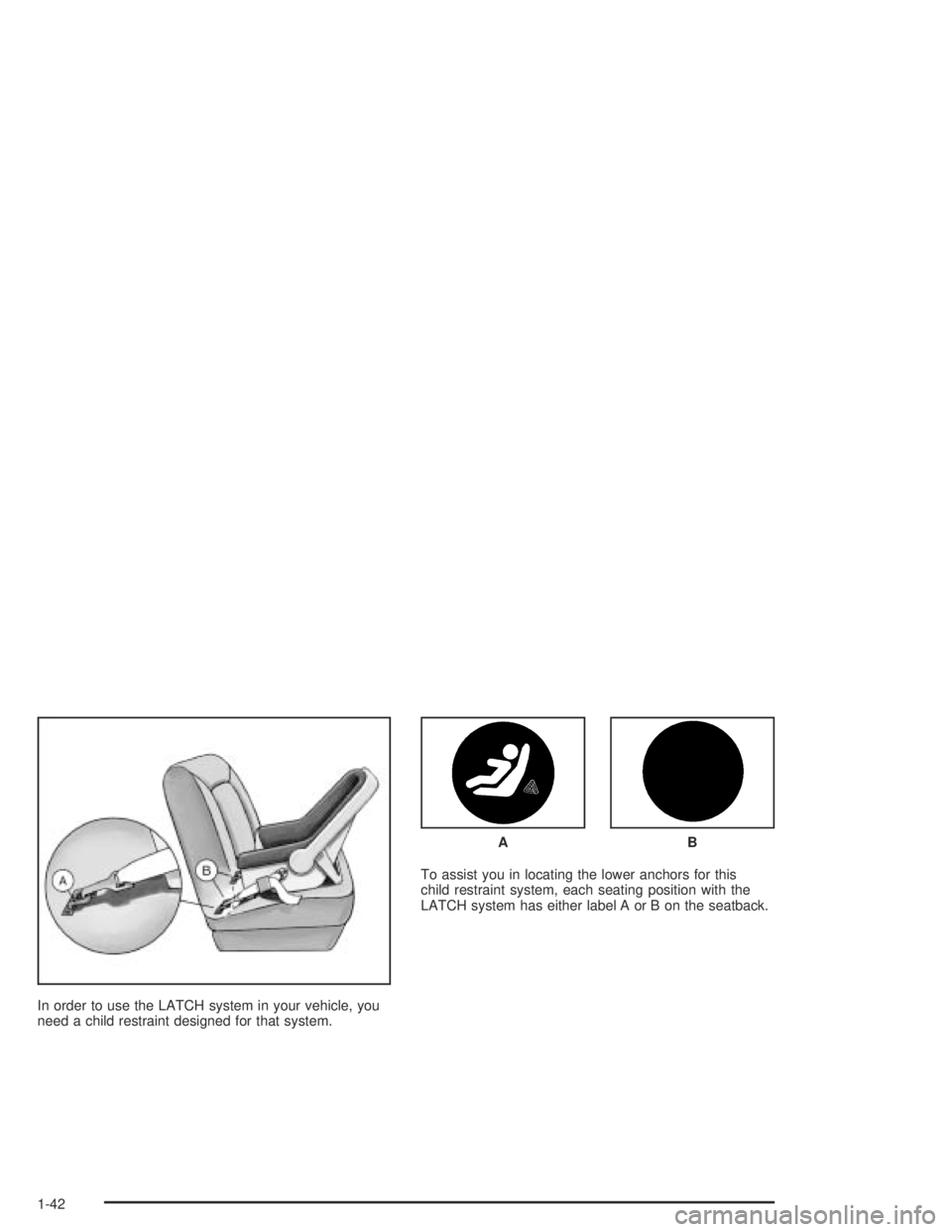
In order to use the LATCH system in your vehicle, you
need a child restraint designed for that system.To assist you in locating the lower anchors for this
child restraint system, each seating position with the
LATCH system has either label A or B on the seatback.
AB
1-42
Page 1492 of 5127
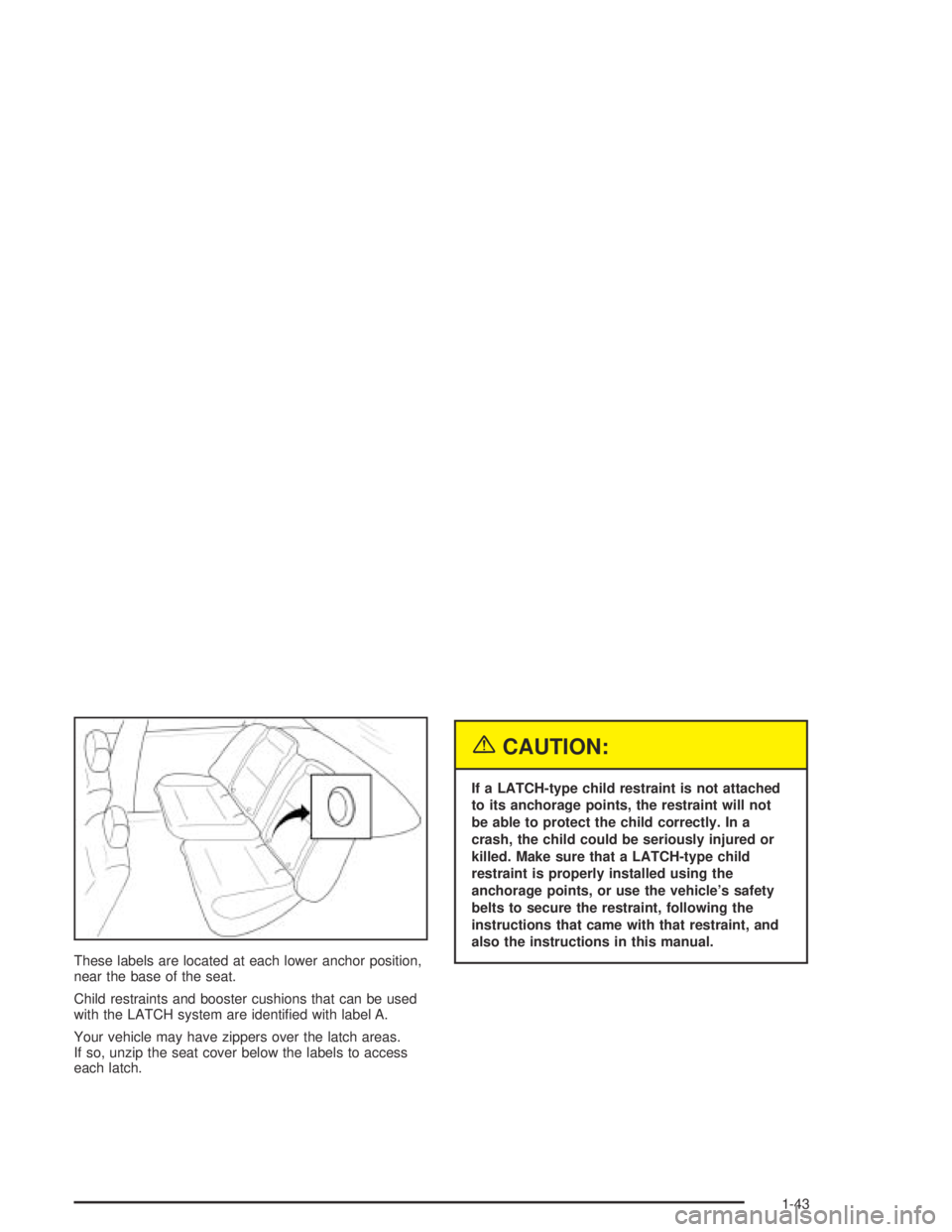
These labels are located at each lower anchor position,
near the base of the seat.
Child restraints and booster cushions that can be used
with the LATCH system are identified with label A.
Your vehicle may have zippers over the latch areas.
If so, unzip the seat cover below the labels to access
each latch.
{CAUTION:
If a LATCH-type child restraint is not attached
to its anchorage points, the restraint will not
be able to protect the child correctly. In a
crash, the child could be seriously injured or
killed. Make sure that a LATCH-type child
restraint is properly installed using the
anchorage points, or use the vehicle’s safety
belts to secure the restraint, following the
instructions that came with that restraint, and
also the instructions in this manual.
1-43
Page 1493 of 5127
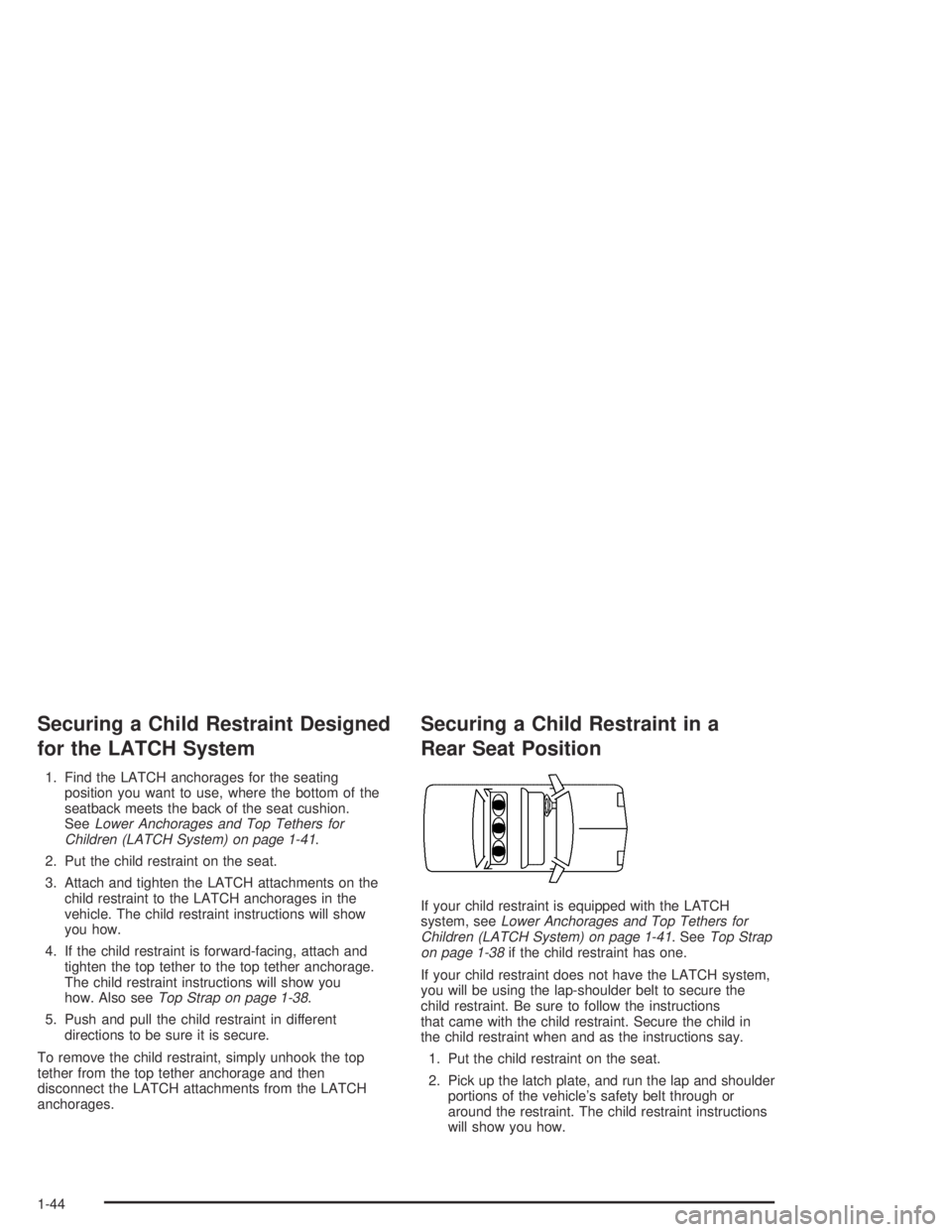
Securing a Child Restraint Designed
for the LATCH System
1. Find the LATCH anchorages for the seating
position you want to use, where the bottom of the
seatback meets the back of the seat cushion.
SeeLower Anchorages and Top Tethers for
Children (LATCH System) on page 1-41.
2. Put the child restraint on the seat.
3. Attach and tighten the LATCH attachments on the
child restraint to the LATCH anchorages in the
vehicle. The child restraint instructions will show
you how.
4. If the child restraint is forward-facing, attach and
tighten the top tether to the top tether anchorage.
The child restraint instructions will show you
how. Also seeTop Strap on page 1-38.
5. Push and pull the child restraint in different
directions to be sure it is secure.
To remove the child restraint, simply unhook the top
tether from the top tether anchorage and then
disconnect the LATCH attachments from the LATCH
anchorages.
Securing a Child Restraint in a
Rear Seat Position
If your child restraint is equipped with the LATCH
system, seeLower Anchorages and Top Tethers for
Children (LATCH System) on page 1-41. SeeTop Strap
on page 1-38if the child restraint has one.
If your child restraint does not have the LATCH system,
you will be using the lap-shoulder belt to secure the
child restraint. Be sure to follow the instructions
that came with the child restraint. Secure the child in
the child restraint when and as the instructions say.
1. Put the child restraint on the seat.
2. Pick up the latch plate, and run the lap and shoulder
portions of the vehicle’s safety belt through or
around the restraint. The child restraint instructions
will show you how.
1-44
Page 1494 of 5127
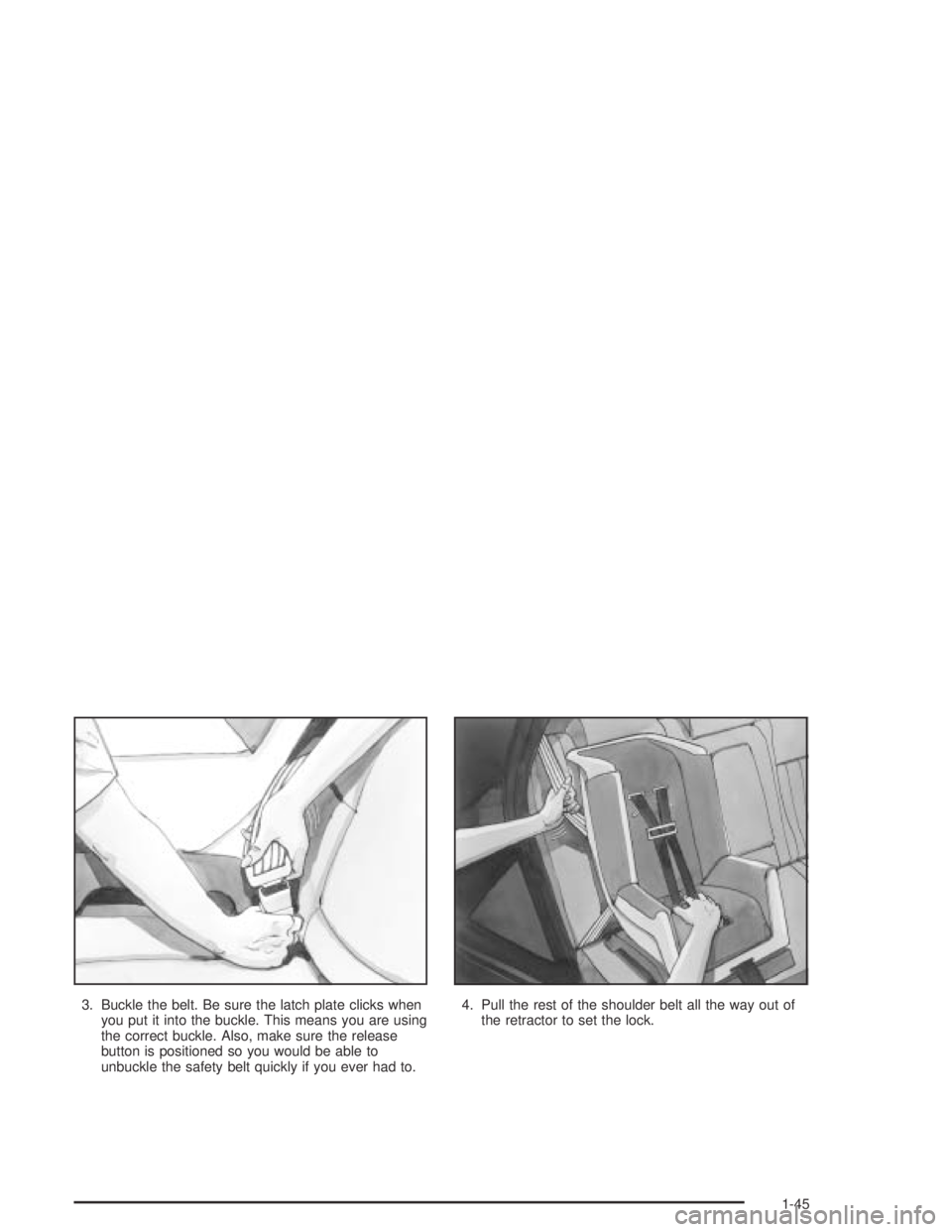
3. Buckle the belt. Be sure the latch plate clicks when
you put it into the buckle. This means you are using
the correct buckle. Also, make sure the release
button is positioned so you would be able to
unbuckle the safety belt quickly if you ever had to.4. Pull the rest of the shoulder belt all the way out of
the retractor to set the lock.
1-45
Page 1495 of 5127
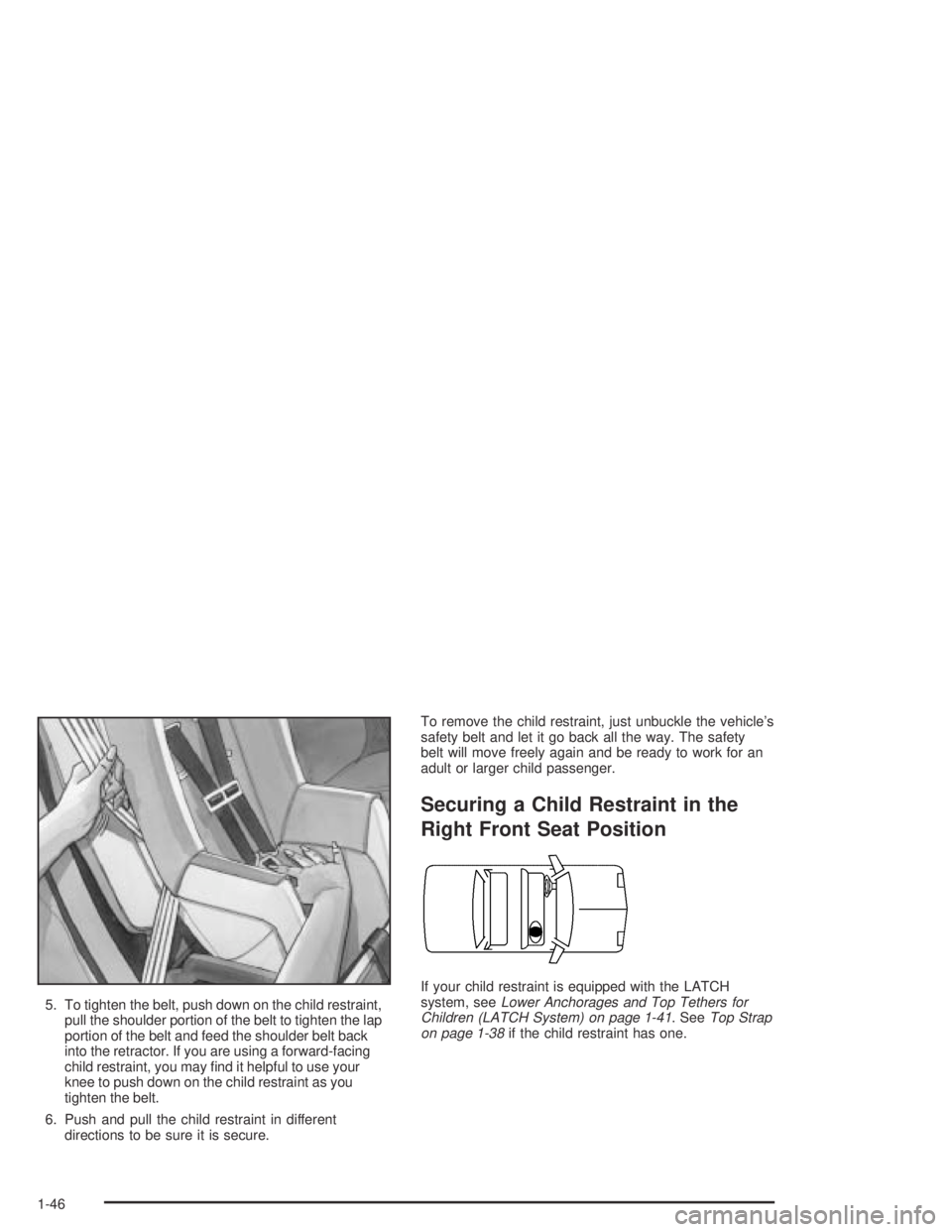
5. To tighten the belt, push down on the child restraint,
pull the shoulder portion of the belt to tighten the lap
portion of the belt and feed the shoulder belt back
into the retractor. If you are using a forward-facing
child restraint, you may find it helpful to use your
knee to push down on the child restraint as you
tighten the belt.
6. Push and pull the child restraint in different
directions to be sure it is secure.To remove the child restraint, just unbuckle the vehicle’s
safety belt and let it go back all the way. The safety
belt will move freely again and be ready to work for an
adult or larger child passenger.
Securing a Child Restraint in the
Right Front Seat Position
If your child restraint is equipped with the LATCH
system, seeLower Anchorages and Top Tethers for
Children (LATCH System) on page 1-41. SeeTop Strap
on page 1-38if the child restraint has one.
1-46
Page 1496 of 5127
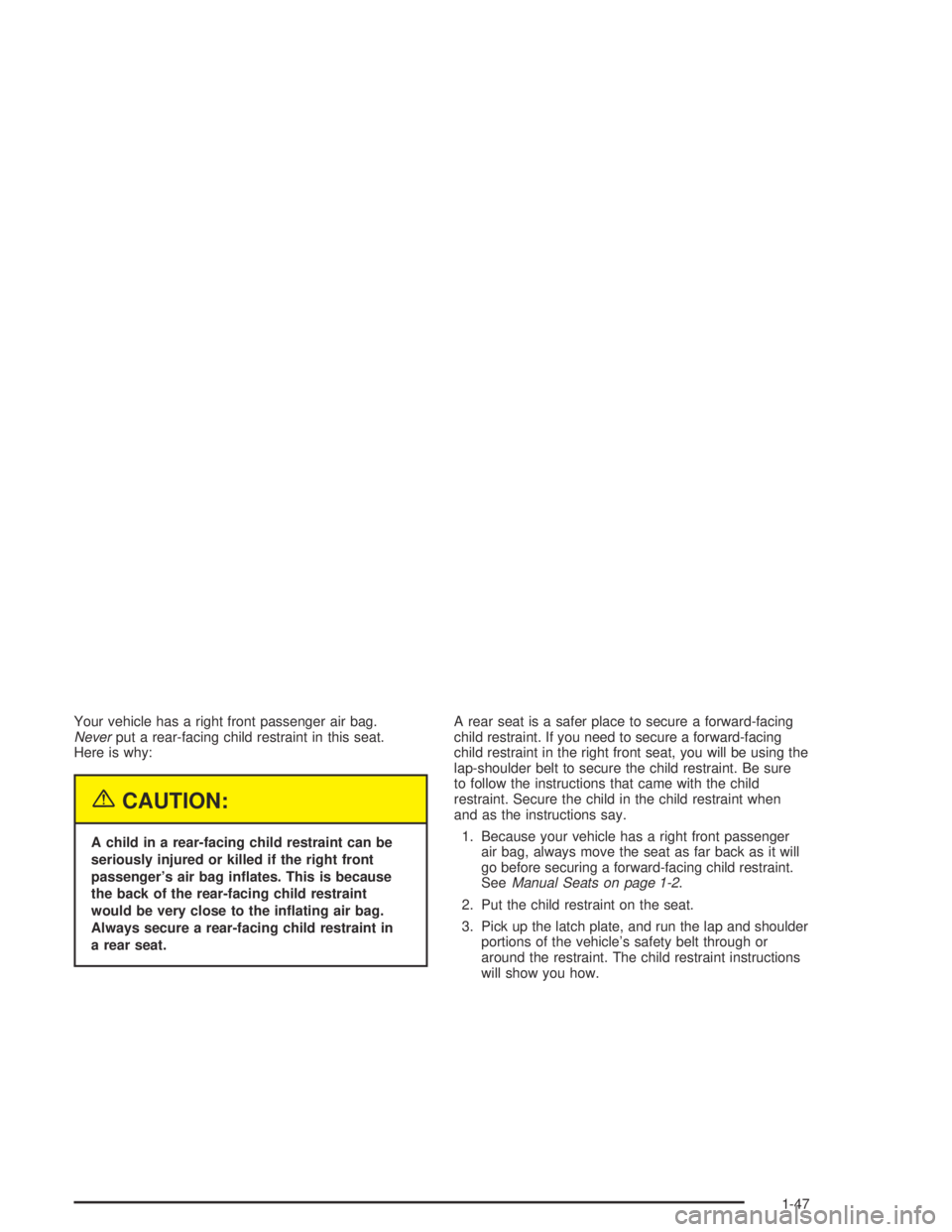
Your vehicle has a right front passenger air bag.
Neverput a rear-facing child restraint in this seat.
Here is why:
{CAUTION:
A child in a rear-facing child restraint can be
seriously injured or killed if the right front
passenger’s air bag in�ates. This is because
the back of the rear-facing child restraint
would be very close to the in�ating air bag.
Always secure a rear-facing child restraint in
a rear seat.A rear seat is a safer place to secure a forward-facing
child restraint. If you need to secure a forward-facing
child restraint in the right front seat, you will be using the
lap-shoulder belt to secure the child restraint. Be sure
to follow the instructions that came with the child
restraint. Secure the child in the child restraint when
and as the instructions say.
1. Because your vehicle has a right front passenger
air bag, always move the seat as far back as it will
go before securing a forward-facing child restraint.
SeeManual Seats on page 1-2.
2. Put the child restraint on the seat.
3. Pick up the latch plate, and run the lap and shoulder
portions of the vehicle’s safety belt through or
around the restraint. The child restraint instructions
will show you how.
1-47
Page 1497 of 5127
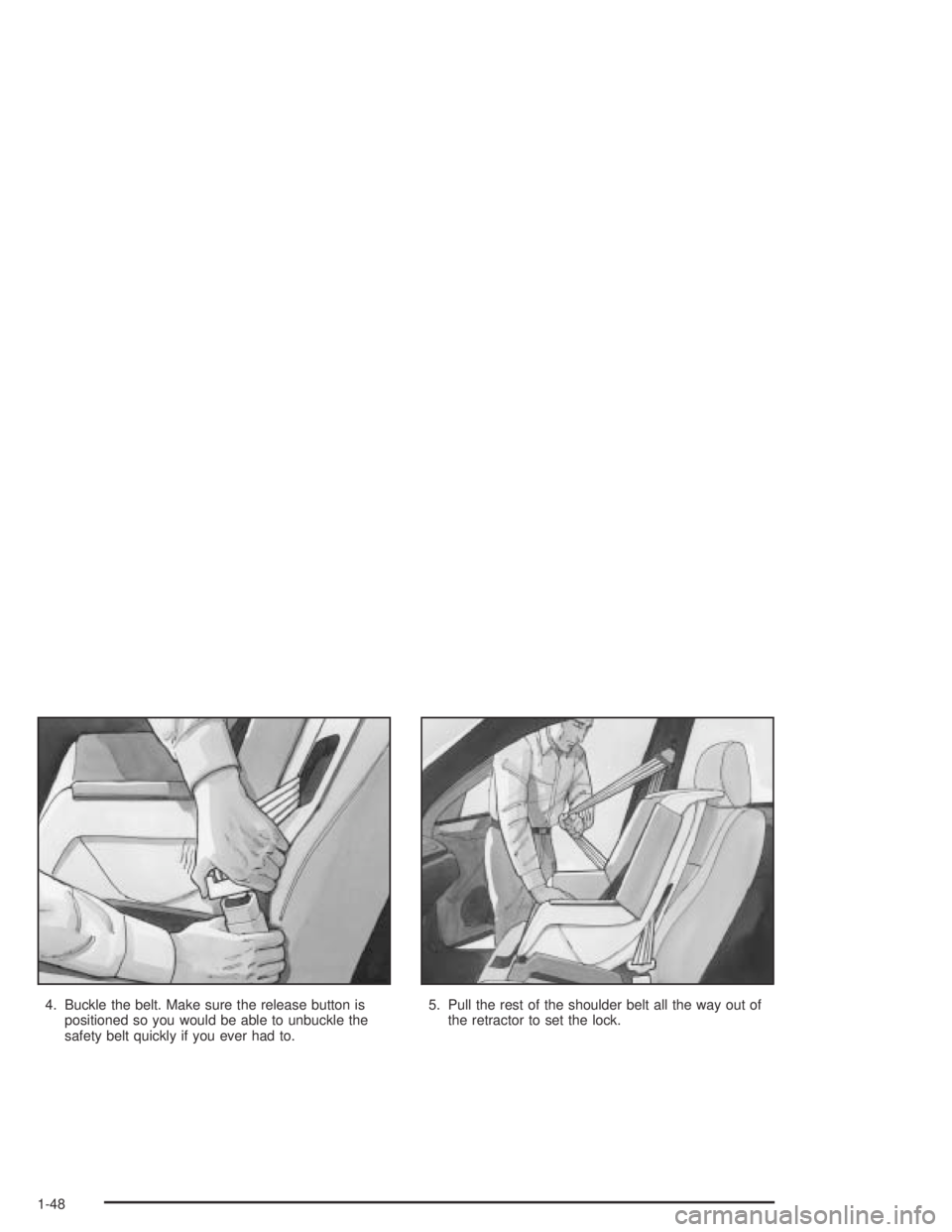
4. Buckle the belt. Make sure the release button is
positioned so you would be able to unbuckle the
safety belt quickly if you ever had to.5. Pull the rest of the shoulder belt all the way out of
the retractor to set the lock.
1-48
Page 1498 of 5127
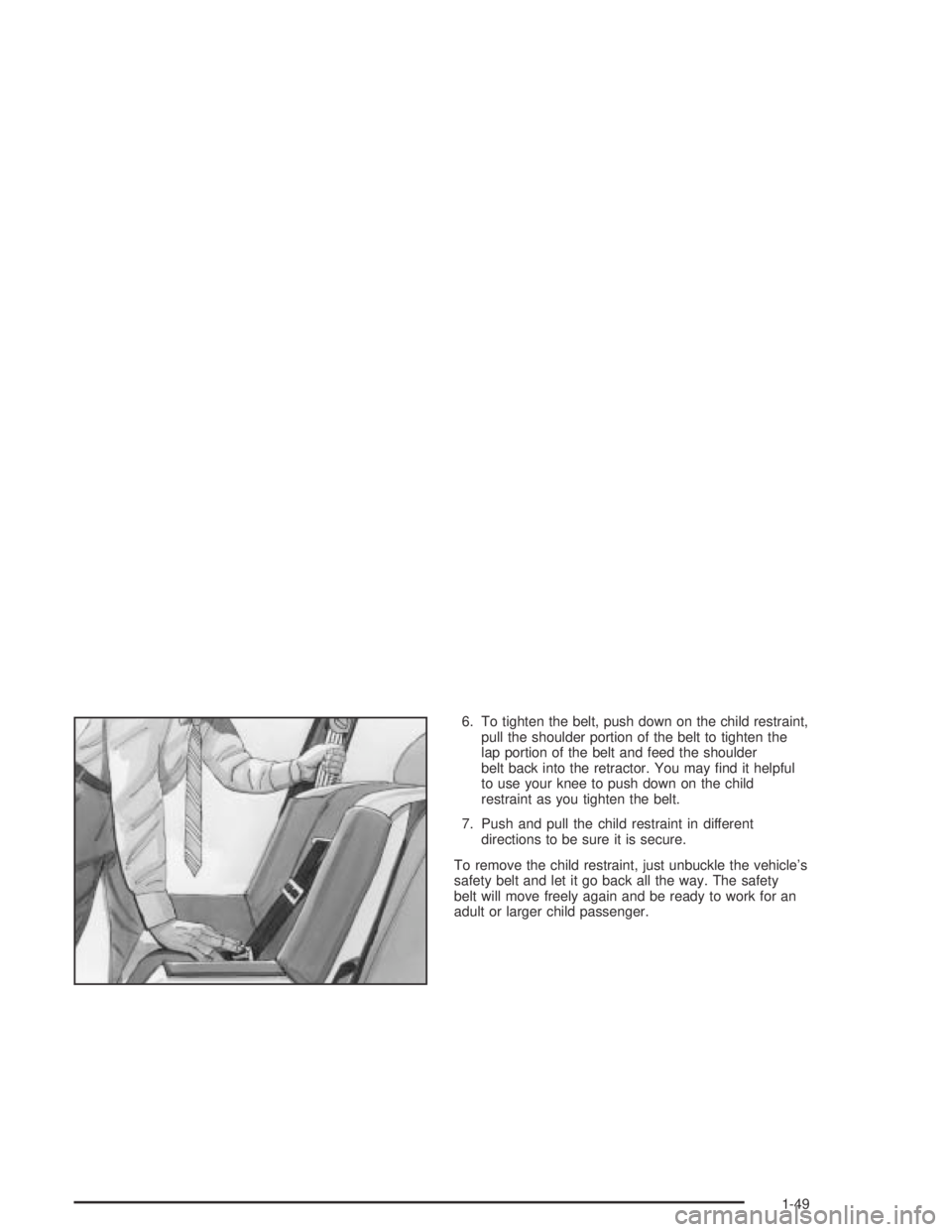
6. To tighten the belt, push down on the child restraint,
pull the shoulder portion of the belt to tighten the
lap portion of the belt and feed the shoulder
belt back into the retractor. You may find it helpful
to use your knee to push down on the child
restraint as you tighten the belt.
7. Push and pull the child restraint in different
directions to be sure it is secure.
To remove the child restraint, just unbuckle the vehicle’s
safety belt and let it go back all the way. The safety
belt will move freely again and be ready to work for an
adult or larger child passenger.
1-49
Page 1499 of 5127
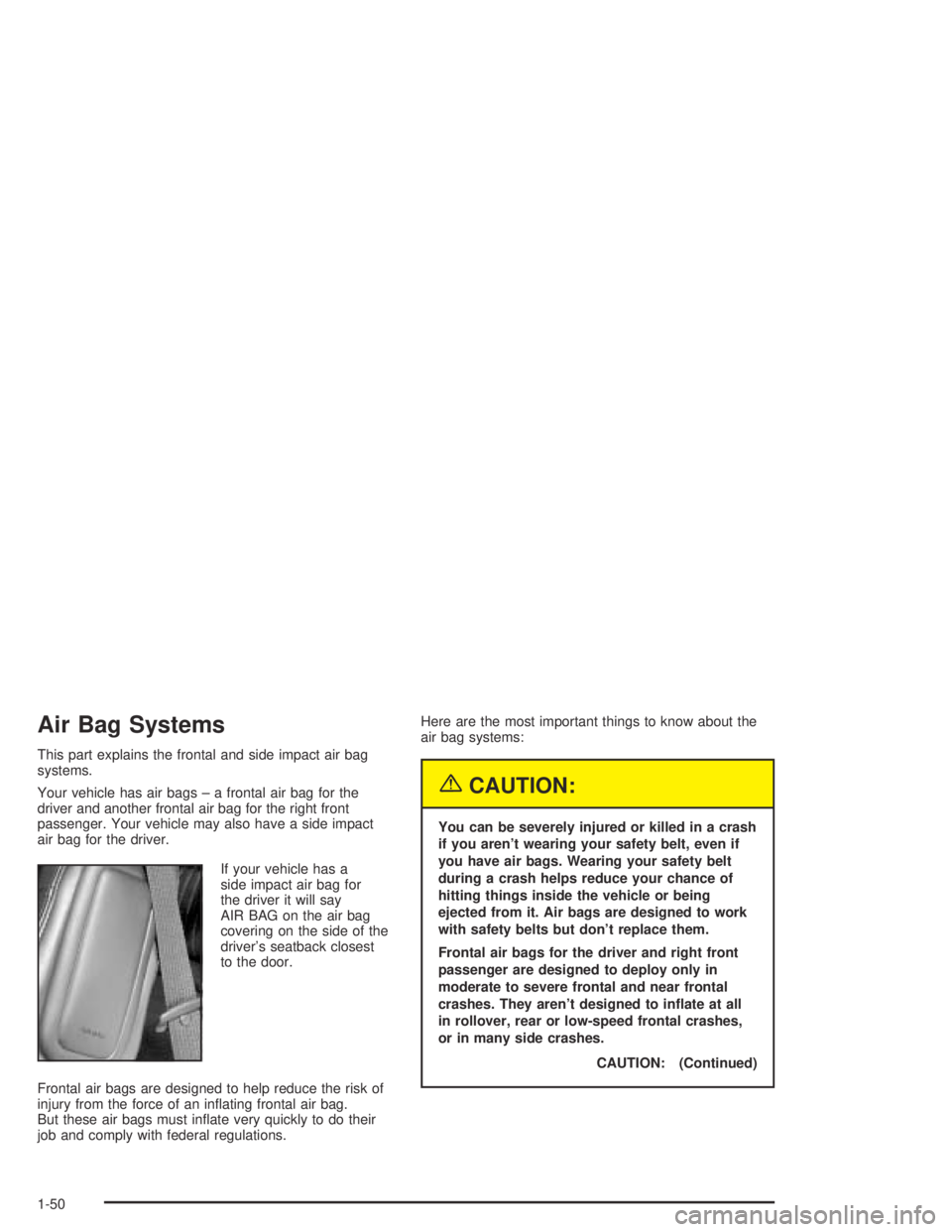
Air Bag Systems
This part explains the frontal and side impact air bag
systems.
Your vehicle has air bags – a frontal air bag for the
driver and another frontal air bag for the right front
passenger. Your vehicle may also have a side impact
air bag for the driver.
If your vehicle has a
side impact air bag for
the driver it will say
AIR BAG on the air bag
covering on the side of the
driver’s seatback closest
to the door.
Frontal air bags are designed to help reduce the risk of
injury from the force of an inflating frontal air bag.
But these air bags must inflate very quickly to do their
job and comply with federal regulations.Here are the most important things to know about the
air bag systems:
{CAUTION:
You can be severely injured or killed in a crash
if you aren’t wearing your safety belt, even if
you have air bags. Wearing your safety belt
during a crash helps reduce your chance of
hitting things inside the vehicle or being
ejected from it. Air bags are designed to work
with safety belts but don’t replace them.
Frontal air bags for the driver and right front
passenger are designed to deploy only in
moderate to severe frontal and near frontal
crashes. They aren’t designed to in�ate at all
in rollover, rear or low-speed frontal crashes,
or in many side crashes.
CAUTION: (Continued)
1-50
Page 1500 of 5127
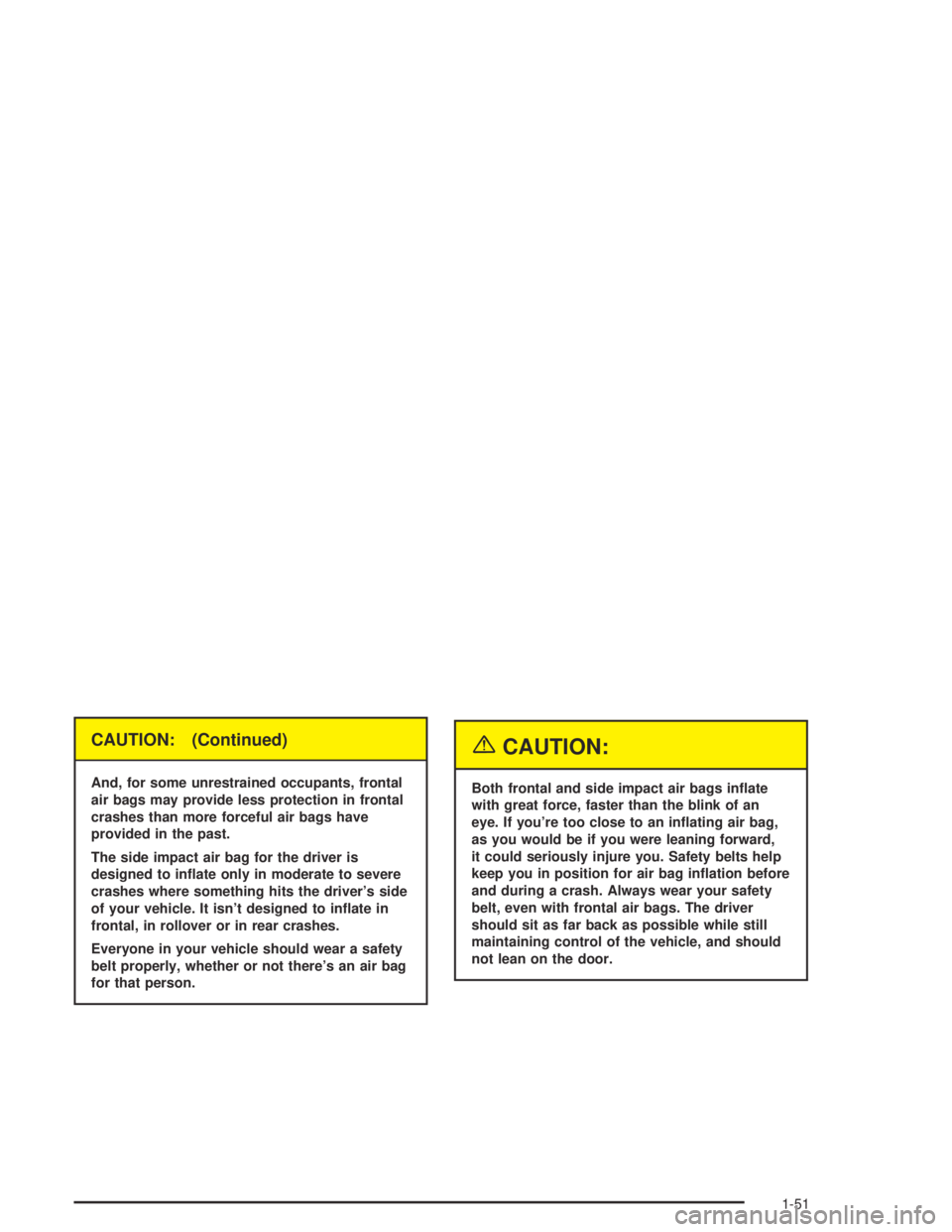
CAUTION: (Continued)
And, for some unrestrained occupants, frontal
air bags may provide less protection in frontal
crashes than more forceful air bags have
provided in the past.
The side impact air bag for the driver is
designed to in�ate only in moderate to severe
crashes where something hits the driver’s side
of your vehicle. It isn’t designed to in�ate in
frontal, in rollover or in rear crashes.
Everyone in your vehicle should wear a safety
belt properly, whether or not there’s an air bag
for that person.
{CAUTION:
Both frontal and side impact air bags in�ate
with great force, faster than the blink of an
eye. If you’re too close to an in�ating air bag,
as you would be if you were leaning forward,
it could seriously injure you. Safety belts help
keep you in position for air bag in�ation before
and during a crash. Always wear your safety
belt, even with frontal air bags. The driver
should sit as far back as possible while still
maintaining control of the vehicle, and should
not lean on the door.
1-51